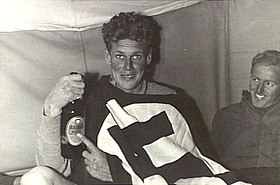Wilfred Arthur
Born in Sydney and raised in rural Queensland, Arthur enlisted in the RAAF the day after Australia joined the war in September 1939.
He achieved victories in all three types against German and Italian opponents, and was awarded the Distinguished Flying Cross for shooting down four aircraft in a single sortie in November 1941.
The next month Arthur married a young woman he met in Alexandria, and organised for her to travel with him on his troopship when he was posted back to Australia in January 1942.
He received the Distinguished Service Order in April for continuing to lead an attack on a formation of Japanese bombers after discovering that his guns were inoperable.
71 Wing, Arthur was involved in a runway collision with an RAAF Spitfire in November and suffered severe burns necessitating repatriation to Australia.
Twice mentioned in despatches during the war, Arthur also played a leading part in—and gave name to—the "Morotai Mutiny" of April 1945, when eight RAAF officers attempted to resign their commissions in protest against apparently worthless ground-attack operations.
[2] Stanley Arthur was a veteran of World War I, serving with the Australian Army Veterinary Corps in Egypt and France; two of his brothers also saw active service.
[4][6] In 1935 he began boarding at the Scots College in Warwick, where he matriculated; he was also a member of the school cadet corps and excelled in sports such as cricket, tennis, swimming, athletics, and shooting.
[2][4] Known by his father's forename in youth, Arthur later gained an array of appellations including "Bandy", "Wilf", "Wolf",[4] and "Wulf",[7] but most commonly "Woof".
[9] On 15 July, the squadron departed Sydney for the Middle East to support the 6th Division in the Western Desert campaign against Italian forces.
[14] On 2 November, two flights of the squadron moved forward to Gerawla, near Mersa Matruh, equipped with Gloster Gladiator biplane fighters.
[5][19] Bailing out, Arthur narrowly avoided disaster when he became entangled first with his oxygen hose and then with the Gladiator's wing-bracing wires; he was only torn loose at a height of 1,000 feet (300 m) by the force of rushing air as his stricken plane fell to Earth.
[5][20] Arthur was credited with another CR.42 destroyed, and one damaged, north-east of Sollum Bay on 26 December, when his squadron attacked a formation of SM.79s escorted by over twenty CR.42s.
[18][21] On 22 January 1941, Arthur and Flying Officer Alan Rawlinson were despatched in Gladiators to attack an Italian schooner off Tobruk; they machine-gunned the vessel, setting it on fire.
3 Squadron eventually re-located to Sidi Haneish in Egypt on 12 April, having retreated 500 miles (800 km) and operated from nine airfields in ten days.
[9] Flying a Tomahawk, he was credited with one Messerschmitt Bf 109 fighter probably destroyed, and another damaged, in the vicinity of Sheferzen, Egypt, on 12 October.
3 and 112 Squadrons intercepted fifteen Junkers Ju 87 Stuka dive bombers escorted by twenty-five German and Italian fighters heading to attack New Zealand troops at Sidi Rezegh; No.
[4][46] Arthur recalled that they sailed via Bombay and Colombo, where the ship picked up many refugees following the recent fall of Singapore, before arriving in Melbourne on 28 March.
[47] As the Japanese advanced in the South West Pacific during early 1942, the RAAF hurriedly established three new fighter units for the defence of Australia and New Guinea, Nos.
Despite being, at twenty-three, the youngest officer in his new squadron, he commanded the respect of his fellows because, he believed, "they like that I work hard; they like that I am not frightened of anything (i.e. Pretends not to be) and above those, they like that I don't boast".
[54] Arthur was awarded the Distinguished Service Order (DSO) for his "gallantry, matchless leadership and devotion to duty" in action over Milne Bay on 14 April 1943.
75 and 77 Squadrons and P-38 Lightnings of the USAAF, in what his DSO citation described as "a determined head-on attack" to intercept 100 Japanese raiders, fourteen of which the defenders claimed as destroyed.
1 TAF was mainly assigned to garrison duties and harassing Japanese bases on islands bypassed by US forces advancing on the Philippines and Japan.
[69] Flying his first mission on 22 December 1944, Arthur began to doubt the value of some targets considering the risk his pilots faced from ground fire, and cancelled three days of operations on his own authority.
According to historian Mark Johnston, "His letters at this time reveal a thoughtful and perhaps restless man, grappling with political and religious issues.
[12][17][18][76] Reflecting on being a fighter pilot throughout his military career, Arthur said that he was glad to have flown single-seat aircraft rather than bombers, because "I would always have felt very uncomfortable with anybody else for whom I'd be responsible".
[80] Subsequently working for the Repatriation Department, in 1950 he joined the Australian School of Pacific Administration, and in 1961 travelled to Vietnam to establish a dairy farm at Bến Cát under the Colombo Plan.
[4][84] Returning to Australia, Arthur took up residence in Darwin, Northern Territory, in 1967 and became administration manager for Geopeko, the exploration unit responsible for discovering the Ranger uranium deposit at Jabiru.
[4] The Kittyhawk "Polly" that Arthur flew in his DSO-winning action of 14 April 1943 was purchased by the Australian War Memorial, Canberra, in 1992 and put on display in its Aircraft Hall.
[86][87] In 2011, the Scots College at Warwick opened the Wilf Arthur Learning Enrichment Centre, which featured a scale model of "Polly".



